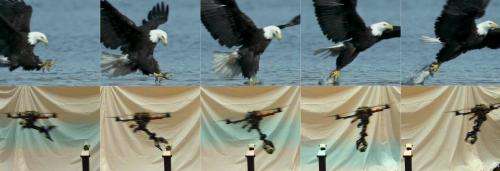March 17, 2013 report
Eagle-eyeing researchers design swooping quadrotors with claws (w/ video)

(Phys.org) —Scientists working on robots often concentrate on how to mimic the shape and movements of animals that show exceptional efficiencies in varied tasks; a recent team accomplishment takes a page out of the study of eagles, in order to create a flying robot that can similarly swoop down and grab objects the way an eagle can fish with its natural claws. Fundamentally, they were after a goal of devices capable of high-speed aerial grasping and manipulation. Scientists at the University of Pennsylvania made a quadrotor equipped with a special gripper that can grasp objects while in flight.
The team discussed their work in their paper, "Avian-Inspired Grasping for Quadrotor Micro-UAVs." The authors are Justin R. Thomas, Joe J. Polin, Koushil Sreenath, and Vijay Kumar of the GRASP Lab at the University of Pennsylvania.
These robotics scientists designed a gripping arm like a talon as part of a small unmanned aerial vehicle (UAV). These quadrotors are shown in the team's video as high-speed devices flying with their claws attached to motorized legs and snatching objects as they fly by. The researchers referred to their creation as "a novel appendage design, inspired by the articulation of an eagle's legs and claws."
They took inspiration not only in how the birds are shaped but in strategies that they use at the crucial dive and swoop pickup point. Movement strategy was key. To ensure they catch their prey, the birds sweep legs and claws backwards to gain time to make a secure grip without having to reduce speed. As they described in the paper, "an Eagle sweeps its legs and claws backwards during its capture phase, thereby reducing the relative velocity between the claws of the predator and the prey."
They said the backwards strategy gives the birds near-zero relative velocity of the claw while grasping the target and not slowing down, resulting in a high rate of success, even with, in a fish-grabbing scenario, other luckier fish detecting a predator soon enough in advance and moving out of the way.
The researchers plan to take the project and move in further directions. They said they want to try accomplishing the same results without using the Vicon motion capture system. They intend to try algorithms in which "the errors between the desired target position and actual position in the retina drive the robot."
They said that since an eagle can navigate using only its visual and inertial sensors, "a quadrotor should be able to make in-flight corrections using data from an on-board camera."
Another agenda item for future research will be designs for making appendages with lower inertia, to enable more agile grasping as well as perching strategies.
More information:
www.seas.upenn.edu/~koushils/P … ations/IDETC2013.pdf
www.seas.upenn.edu/~koushils/research.html
© 2013 Phys.org





















